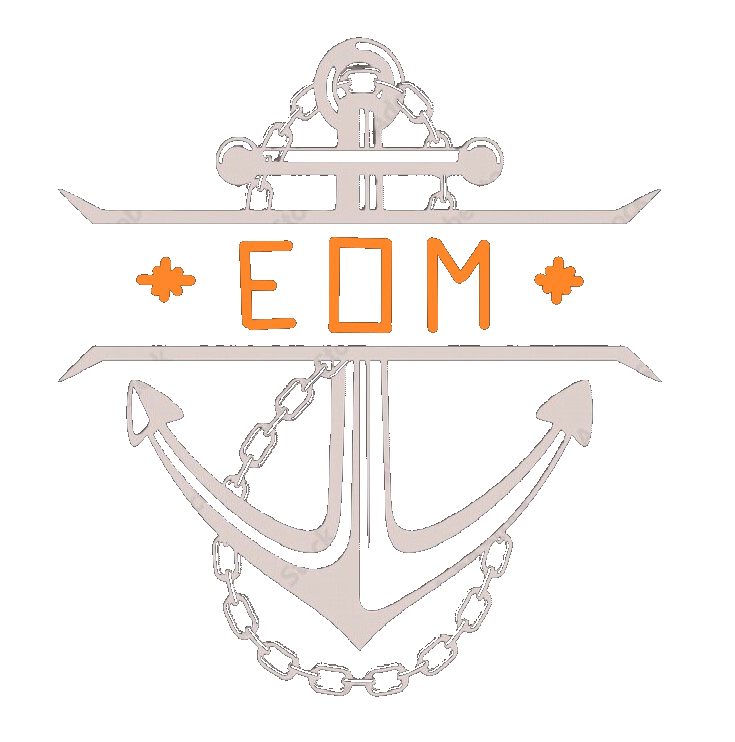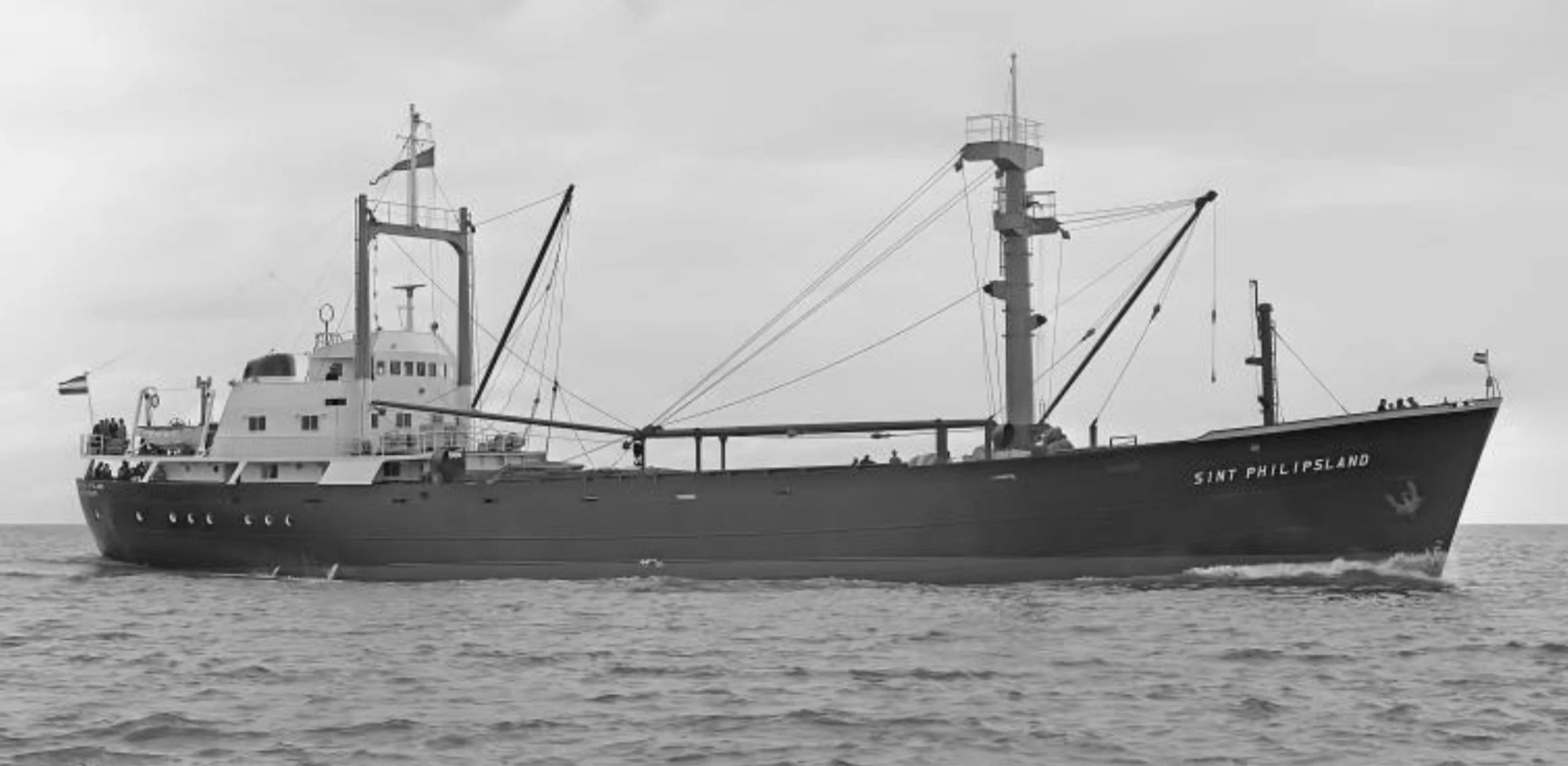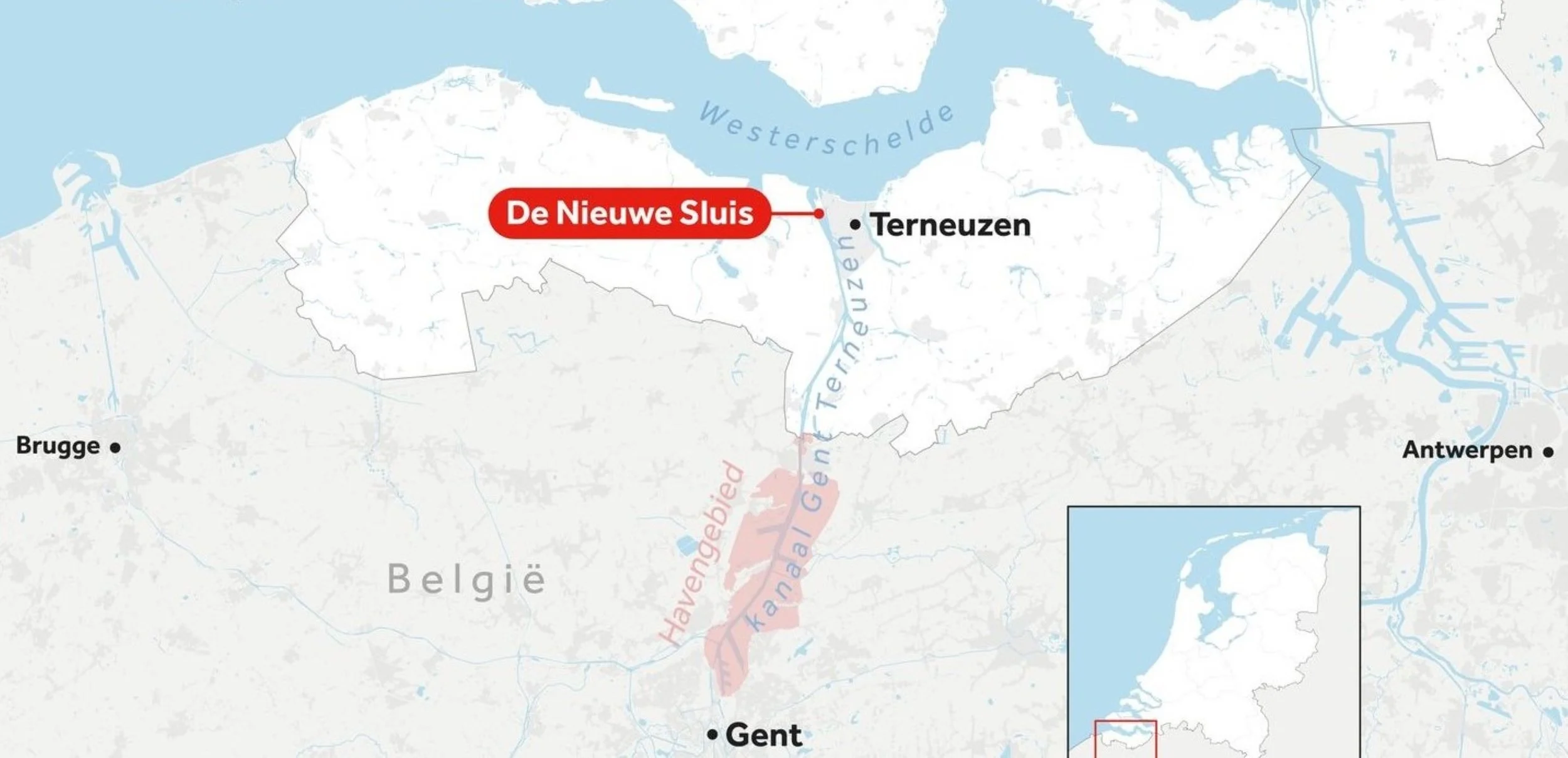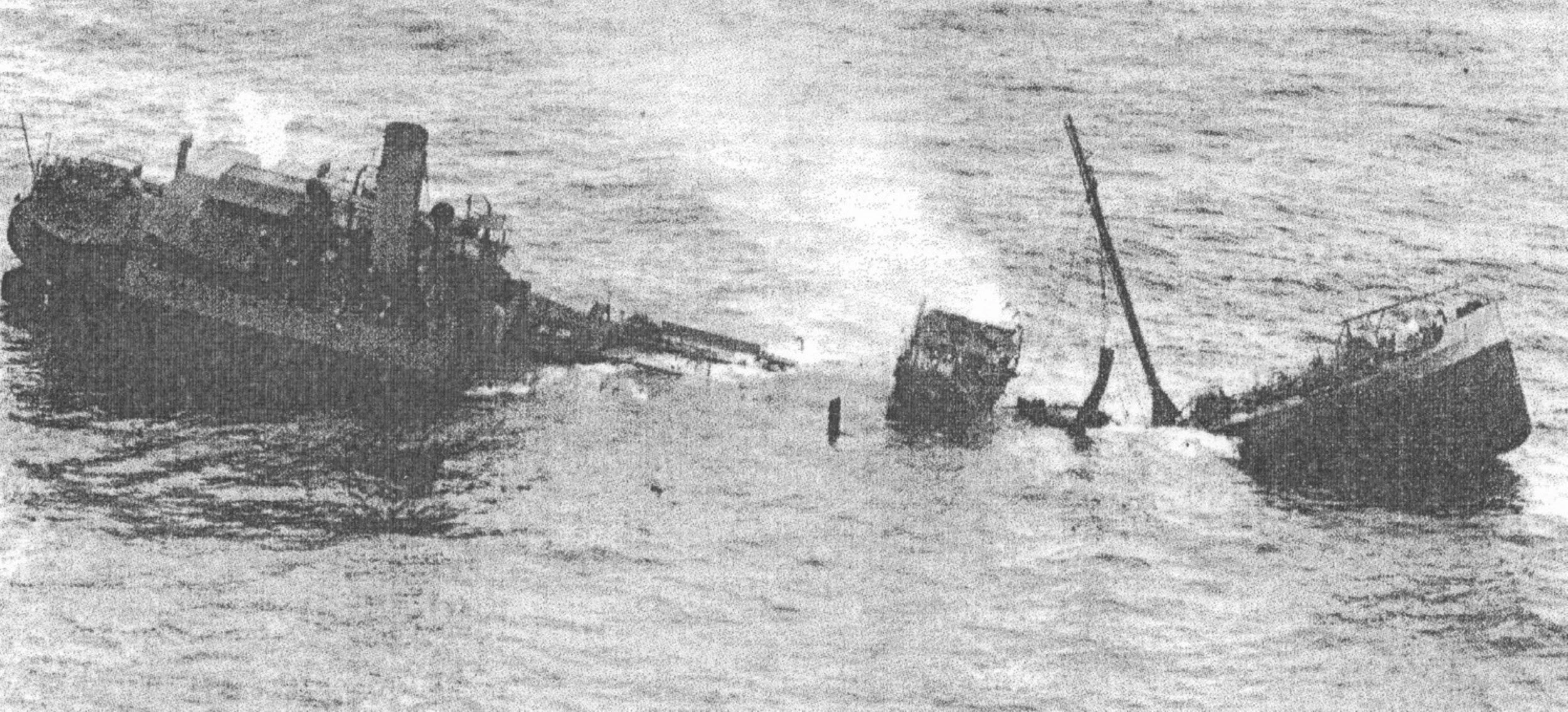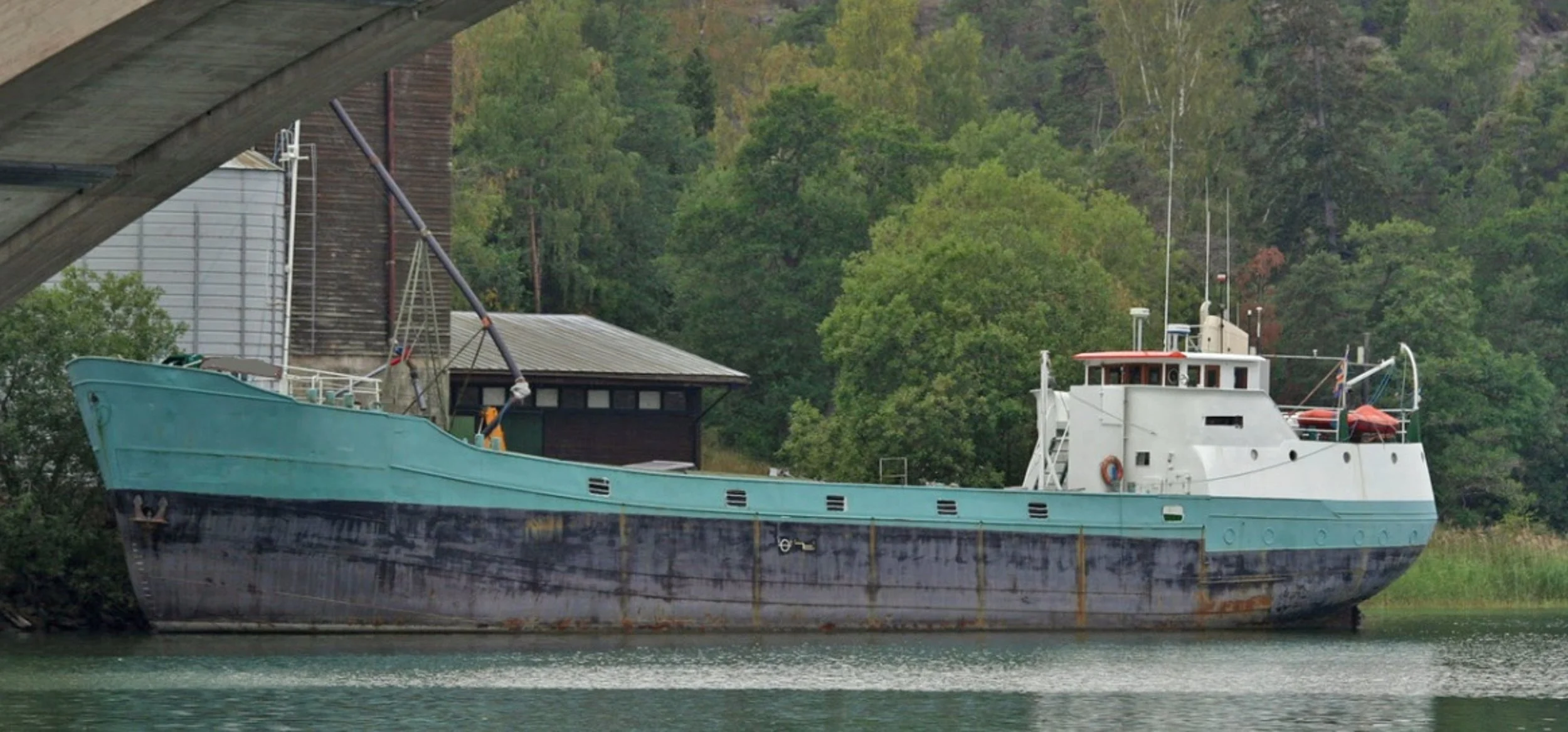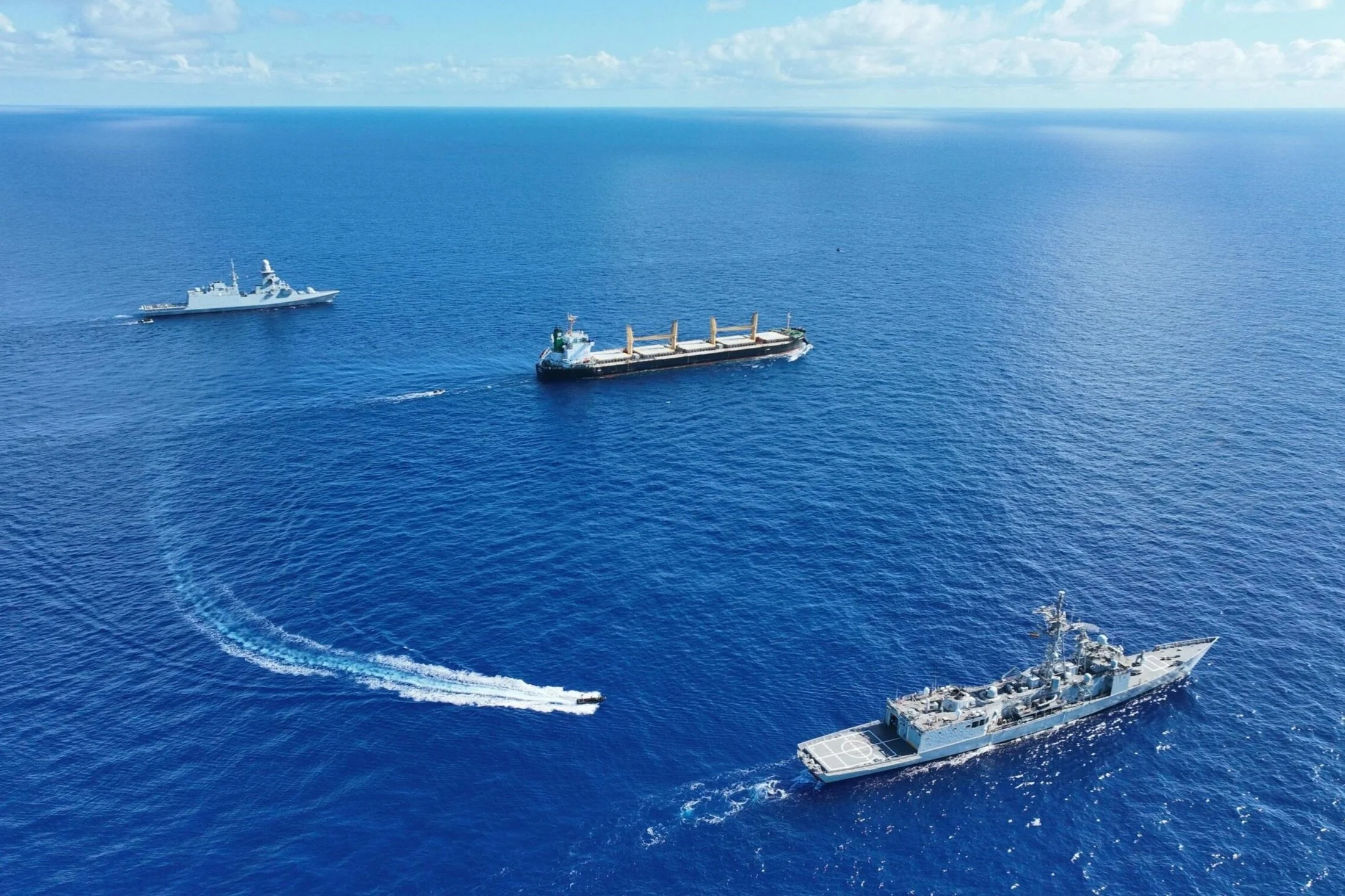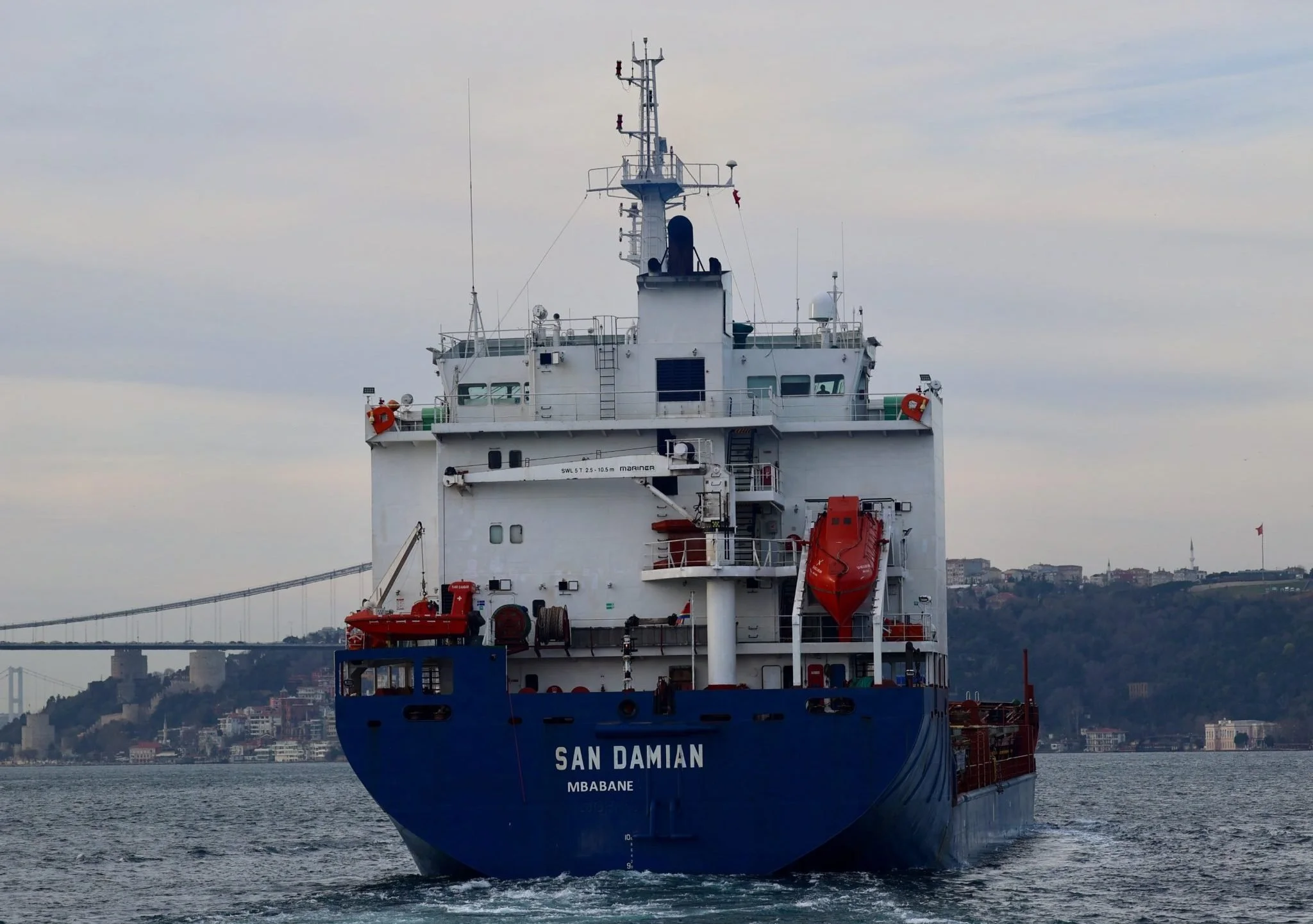The tragic story of D.S.S. SLAMAT
D.S.S. SLAMAT under attack.
On April 27, 1941, the Rotterdamsche Lloyd passenger ship SS "SLAMAT," the largest ship in the convoy, came under fire from Luftwaffe Stukas in Greek waters, caught fire, and sank. The proud passenger ship was involved in Operation Demon, a large-scale evacuation of Allied soldiers from Greece under British command. En route to the south, which had been deemed safe, the convoy was attacked by Stukas, and contrary to the code of war, lifeboats and rafts carrying survivors were attacked, many being hit and subsequently killed. The British destroyers HMS Diamond and HMS Wryneck rushed to their aid. Both ships took on the few survivors and steamed toward Crete. En route, they too were overtaken by Stukas and sunk. In just a few hours, of the nearly 1,000 people on board, 983 crew members and Allied soldiers lost their lives. Eight nationalities were involved in the disaster. Relatives could only be informed after six months, and in most cases through the Red Cross. This was the biggest sea dissaster in the Dutch history. During World War II, the Dutch Merchant Navy fleet was almost halved. The Rotterdamsche Lloyd even lost 60% of its ships. Because the Netherlands also suffered greatly from the war, the tragedy of the SS "SLAMAT" was forgotten.
For more details, see link below.
https://en.wikipedia.org/wiki/SS_Slamat
Below, I added a collage of postcards that were in a memory booklet, which you received when you were a passenger on board the ship SLAMAT
Ro-ro vessel “Nedlloyd Rouen” /(1995) “Cape Knox”
Vessel “Nedlloyd Rouen” is a roll-on-roll-off vessel built in 1978 by Nippon Kokan Kabushiki Kaisha for Nedlloyd. It is equipped with a 26,800-hp Sulzer 8RND90M that gives the ship a service speed of 19 knots. It is the sister ship of the Nedlloyd Rosario, while the Nedlloyd Rotterdam and Nedlloyd Rochester were two Dutch-built ro-ro's.
The ro-ro's were built for service between the United States and the Middle East where there was then a great need for heavy equipment. After a few years, the need for more luxurious rolling stock increased, but eventually, with an increasing number of container terminals, it became more efficient to use container ships on this service, upon which the ro-ro's were used on other services.
The Dutch ro-ro's had four decks below deck and a length of 196.5m due to port restrictions in Kuwait. These restrictions turned out to be less stringent than initially thought, upon which the Japanese ships became longer. Also, following the Scandinavian model, these had three decks below deck, with two decks able to accommodate two-high containers, although these have to be placed with large forklifts which is therefore labour-intensive. On the main deck, containers could be placed directly by container cranes.
In 1995, the ship was sold to United States Maritime Administration where, as “Cape Knox”, it became part of the National Defense Reserve Fleet. Ro-ro vessel ‘Cape Knox’ is still in service, performing military equipment transports from North America to various parts of the world.
I made my own scale model from an existing kit. This model is painted in the colours of the time when Nedlloyd was the owner and operator of the vessel.
©wikipedia
Model kit “Nedlloyd Rouen”
“Nedlloyd Rouen” ©shipspotting.com
“Cape Knox ©shipspotting.com
mv Sint Philipsland
mv Sint Philipsland - 1962
Vessel named at the place were my family roots lay.
Technical dates:
Year of construction: 1962
Classification Register: Lloyd's Register of Shipping (LR)
IMO number: 5329308
Nat. official number: 11295 Z ROTT 1962
Category: Cargo vessel
Propulsion: Motor Vessel
Type: General Cargo vessel
Deck type: Shelterdeck open
Masts: Two masts
Rig: 4
Material Hull: Steel
Decks: 2
Ship Events Dates:
19-04-1962: SINT PHILIPSLAND launched. At the N.V. Scheepswerf Vooruitgang Gebr. Suurmeyer at Foxhol the new motor coaster St. Philipsland, built on behalf of Scheepvaart en Steenkolen- Mij N.V. at Rotterdam, was successfully launched. The Sint Philipsland is of the shelterdeck type, measures 800 tons d.w. and will be equipped with an 1100 hp engine.
1967-02-28: Het Vrije Volk 28-02-1967: Captain sentenced for using outdated charts. Captain G. B. of Rotterdam is not allowed to sail as captain of sea-going vessels for one week, because he is considered guilty by the Dutch Maritime Court for the grounding of his ship, the SINT PHILIPSLAND (499.23 tonnes, crew of 12) in the Vliesloot (near Vlieland). His helmsman A. der W. faces a similar punishment. Both were found guilty by the council of having used outdated charts when the ship was en route from Rotterdam to Harlingen. The St Phllipsland sustained damage to the steering gear.
12-12-1980: Final Fate:
Moored under arrest at Bombay, India. Sank in shallow water during the night of 19-20 October 1981 due to leakage in engine room. Lifted and again laid up under arrest.
15-12-1984 judicially sold to Goyal Traders Ltd and scrapped by M.P. Steel Corporation at Darukhana near Bombay in October 1984.
Source: Maritieme- Historische Databank
mv Bregaglia first official seagoing vessel to pass new mega lock in Terneuzen (NL).
With a symbolic push of a red button, King Willem-Alexander and Belgian King Filip opened the New Lock in Terneuzen. The construction of the sea lock took more than seven years. The new lock is on Dutch territory, but its main purpose is to make the port near the Belgian city of Ghent more accessible to larger ocean-going vessels.
Kings Filip of Belgium and King Willem-Alexander of the Netherlands.
The lock is 427 meters long, 55 meters wide and almost 16.5 meters deep. This makes the structure one of the largest locks in the world. It is as big as the locks in the Panama Canal.
New North Sea lock. Terneuzen
Geographic position, new North Sea lock.
So the first official Post-Panamax ship to pass through the lock, during the opening ceremony, was the mv Bregaglia. Because of her width of 38 meters, it was previously not possible to pass through the existing locks at Terneuzen.
Passengership Cilicia/ Jan Backx.
Short History:
The Cilicia was a 1938 passenger ship of the British shipping company Anchor Line which was used in the passenger and mail service on the route from Great Britain to India.
From October 1939 she served under the designation HMS Cilicia (F54) as an armed auxiliary cruiser (Armed Merchant Cruiser) and later also as a troop transport in World War II.
In 1946 the Cilicia returned to passenger traffic for the same owner, returned to India and remained in service with the Anchor Line for almost 20 years.
In 1965 she was sold by Anchor Line to Stichting Vakopleiding Havenbedrijf of Rotterdam for use as a training ship and boarding school for nautical college. Berthed at the Parkhaven, she was renamed Jan Backx. This remained untill 1980.
In 1980 was renamed SS Clicia, towed to Bilbao, Spain, where she was scrapped.
Vessel in service with the “Anchore Line”
RMS Cilicia Specifications:
Built: Fairfield Shipbuilding & Engineering Co. Ltd., Govan.
Yard: 664.
Launched: October 21, 1937.
Delivered: May 1938.
Tonnage: 11.136 GRT, 10.287 dwt.
Length: 141.25 m.
Breadth: 20.22 m.
Draft: 8.35 m.
Engines: Two 8-cylinder Fairfield-Doxford diesel engines - 14.000 BHP.
Propellers: Two - 1.110 nhp.
Speed: 18 knots.
Passengers: 321.
Crew: 150.
Names: RMS Cilicia 1938 / HMS Cilicia 1939 / HMT Cilicia 1939 / RMS Cilicia 1945 / Jan Backx 1966 / SS Cilicia 1980
Vessel berthed at Parkhaven, Rotterdam
Pictured from the “Euromast”
Below, my relationship to the passenger ship “Cilicia,” which was later named “Jan Backx.”
In 1979, I went to the Higher Nautical College in Rotterdam, where for the first time the course “SIV” (Mate Small Commercial Shipping) was offered. During this 2-year course I was placed in a boarding school near the school. That boarding school was located on the passenger ship “Jan Backx,” formerly known as “Cilicia.”
The ship was moored under the Euromast in the Parkhaven.
Living on such an old passenger ship was great.
The boarding school regime was strict to shape students in a way that they could perform as reliable officers in the merchant marine.
Escaping, after the compulsory study hours, to the shore was a challenge in order to have a beer on shore. The penalties if you were caught were not pleasant.
After the summer of 1980, the boarding school moved to a former school in Rotterdam-West.
The “Jan Backx,” under the name of “Cilicia,” was towed from her berth to Bilbao, where she was scrapped. This to the sorrow of the former residents of the boarding school. Everyone thought it was a loss at the time.
I have good memories of that time and the stay on the “Jan Backx”.
Happy to have experienced that part of history.
“Jan Bakcx” 1980
Dutch merchant navy casualties during World War II
Dutch merchant shipping played a crucial role in Allied warfare during World War II. Despite the constant threat of German U-boats, bombers and mines, Dutch merchant sailors kept vital supply lines afloat.
Picture: ©Schuttevaer
Extent of sacrifice:
This courage came at a high price. About 3,400 Dutch merchant sailors were directed to die during the war. That was more than 10% of all Dutch war casualties.
Compared to non-maritime groups:
About 2,900 members of the Royal Navy were directed to die. Of the approximately 35,000 Dutch Jews, 28,000 were killed.
Impact on merchant shipping:
The impact of the war on Dutch merchant shipping was enormous. Of the 1,144 Dutch ships that sailed for the Allies, 527 (46%) were lost. The Dutch merchant fleet halved in size.
Recognition and commemoration:
Despite their crucial contribution, merchant mariners by no means always received the recognition they deserved. In the postwar years, however, there has been increasing attention to their sacrifices. In 1996, the Merchant Navy National Monument was unveiled in Rotterdam.Since 2014, there has been an annual National Merchant Navy Commemoration on May 4.
The courage and sacrifice of Dutch merchant sailors during World War II should never be forgotten. They played a vital role in the victory of the Allies and deserve our lasting gratitude.
Source text: Gemini
The Western Scheldt: A crucial link for shipping.
Source: Datema Charts
The Western Scheldt acts as a crucial artery for international shipping. With more than 150,000 ships crossing its waters each year, it plays an undeniable role in the maritime sector. However, its importance extends beyond mere trade flows; it is an indispensable link in the economy, security and international cooperation.
Economic lifeline:
Seaport connection: The Western Scheldt connects the ports of Antwerp and Ghent, two major European ports, with the North Sea. This facilitates the import and export of a wide range of goods, from containers to bulk goods, and boosts the region's economy as well as that of Belgium and the Netherlands.
Hinterland access: The river provides ships with access to the industrial hinterland of Flanders and Wallonia, allowing companies to efficiently bring in raw materials and export finished products.
Safety crucial:
Smooth flow of shipping traffic: The Western Scheldt provides smooth flow of heavy shipping traffic, preventing congestion and potential accidents.
Nautical expertise:
The Joint Nautical Authority, a cooperation between the Netherlands and Belgium, monitors the safety of shipping on the Western Scheldt.
International cooperation:
The Western Scheldt symbolizes the close cooperation between the Netherlands and Belgium on maritime matters. Both countries recognize the importance of the river for their economy and safety, and work together to optimize its efficiency and sustainability.
Future perspective:
The Western Scheldt retains its undeniable position in the future. Increasing globalization and maritime trade will only reinforce its importance as a waterway and economic link. Sustainable development and innovative solutions will be central to arming the river to meet the challenges of climate change and increasing ship traffic.
The Western Scheldt is more than a waterway; it is a vital pulse at the heart of Europe's maritime sector, symbolizing prosperity, security and international cooperation.
Source text: Gemini
Intermodal transport by sea.
Intermodal transport by sea offers efficient and sustainable transportation to your destination. This method involves the transport of containers or standardized cargo units without transshipping between different modes of transport. The process begins with the containers being loaded onto trucks and taken to the port, where they are then loaded onto an ocean-going vessel. Upon arrival at the destination port, the containers are transferred onto trains or trucks for the final leg of the journey to the destination.
There are several benefits to intermodal transport by sea. Firstly, it is a sustainable option, as ships emit less CO2 per kilometer than trucks. Additionally, this method is efficient and saves both time and money since there is no need for transshipping. Intermodal transport also contributes to reducing traffic congestion and improves reliability as it is less affected by weather delays.
Intermodal transport by sea is particularly suitable for large shipments that need to be transported over long distances. It is also a good choice for urgent shipments when compared to trucking. Overall, this method offers an efficient and environmentally-friendly solution for transporting goods.
Source: Gemini
All you want to know about a 20” container. (Source: Marine Insight)
Brief history of coastal navigation.
600 mt DW coaster.
Source text: Gemini
Coastal navigation is as old as mankind itself. As early as prehistoric times, people ventured out to sea in small boats to sail along the coast and fish or trade. The development of shipbuilding and navigation techniques made it possible to travel ever greater distances and transport more goods.
During the Middle Ages, coastal navigation was an important branch of trade in Europe. Merchants transported all kinds of products along the coasts, such as wine, grain, salt and fish. The Hanseatic League was a powerful trade association that played an important role in the development of coastal shipping in northern Europe.
The advent of the steam engine in the 19th century revolutionized coastal shipping. Steamships were much faster and more efficient than sailing ships, making it possible to transport even more goods over greater distances. This led to a huge increase in trade and prosperity.
In the 20th century, coastal shipping became increasingly modernized. New types of ships were developed, such as tankers and container ships, which were even more efficient and could carry more cargo. However, the rise of the automobile and airplane also meant that there was less demand for coastal shipping.
mv Ladyhester
Source text: Gemini
Today, coastal shipping is still an important industry, but its role has changed. Coastal vessels are mainly used to transport bulk goods, such as oil, gas, chemicals and construction materials. Coastal shipping is an important link in the modern logistics chain and plays an important role in the global economy.
In addition to its economic significance, coastal shipping also has an important cultural and historical value. Coastal ships and ports are often iconic symbols of a city or region. The stories of sailors and merchants contribute to the heritage of coastal shipping.
EU naval operation warns ransom payments to pirates could trigger more attacks.
EUNAVFOR Operation Atalanta warships escort the MV Abdullah after it was freed by Somali pirates. (© EUNAVFOR)
Source: gCaptain - Mike Schuler
The European Union’s counter-piracy naval operation off the Somali coast, known as Operation Atalanta, has reiterated its warning that ransom payments could potentially exacerbate the piracy issue off the Horn of Africa and the Indian Ocean.
The warning comes on the heels of the release of the Bangladesh-flagged MV Abdullah, which was hijacked on March 12 and freed April 14 reportedly after a ransom payment of $5 million was made to pirates.
Since November 2023, the Somali basin has witnessed multiple piracy and hijacking incidents, prompting fears of a return of Somali-based piracy. As many as 18 dhows have been hijacked, with some already released while six to seven remain captive. Operation Atalanta has also identified potential pirate camps along the Somali coast, with a significant concentration north of Eyl.
Three merchant vessels have been attacked, among them two confirmed hijackings includiing the Abdullah. Another vessel, the MV Ruen, was hijacked in mid-December and freed last month following an operation by the Indian Navy. Suspicious approaches to several other vessels have also been reported.
Operation Atalanta estimates that at least one or more pirate action groups (PAGs) could be active off the Somali coast, particularly around Socotra Island.
Typical piracy tactics involve the seizure of a dhow that is then used as a mother ship from which skiffs are deployed to attack vessels navigating up to 600 nautical miles east of the Somali coast. Attacks in the Gulf of Aden (GOA) are also possible. Once a ship is seized, it is likely taken to the Somali coast where it is held during ransom negotiations.
Operation Atalanta warns that the recent ransom payment could trigger a new wave of dhow hijackings, leading to future skiff attacks on merchant vessels.
“Although there have been no piracy-related incidents in the past seven days, the payment of ransom could create a new wave of Dhow hijackings which in their turn they will create future skiff attacks on M/V etc.,” Operation Atalanta said in an April 15 update. “Considering the occurrence of previous significant attacks on merchant vessels within 12 days after reports of dhow hijackings, and the reports of multiple skiffs, each carrying armed individuals with the intent to capture dhows. ATALANTA continues to assess the threat as Moderate (where an attack is a Realistic Possibility) off the Somali coasts.”
IMO doubts former Swasiland is legitimate flag state.
The registration of ships under the flag of Africa's Eswatini is likely illegal. The former Swasiland began registering ships last November. However, the actual issuance of ship papers was not done by the government. Therefore, Eswatini/Swasiland has been banned as a flag state for the time being.
https://www.schuttevaer.nl/nieuws/actueel/2024/04/24/imo-betwijfelt-of-voormalig-swasiland-legitieme-vlaggenstaat-is/
The San Damian will never be able to reach her home port either.
(© Photo X)
Source: Bart Oosterveld - Schuttevaer (NL)
